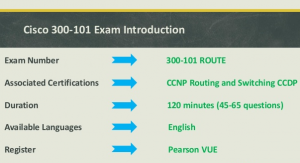Vendor: Cisco
Exam Code: 300-101 exam
Exam Name: Implementing Cisco IP Routing (ROUTE v2.0)
Version: Demo

QUESTION 1
After you review the output of the command show ipv6 interface brief, you see that several IPv6 addresses have the 16-bit hexadecimal value of “FFFE” inserted into the address. Based on 300-101 this information, what do you conclude about these IPv6 addresses?
A. IEEE EUI-64 was implemented when assigning IPv6 addresses on the device.
B. The addresses were misconfigured and will not function as intended.
C. IPv6 addresses containing “FFFE” indicate that the address is reserved for multicast.
D. The IPv6 universal/local flag (bit 7) was flipped.
E. IPv6 unicast forwarding was enabled, but IPv6 Cisco Express Forwarding was disabled.
Correct Answer: A
Explanation: Extended Unique Identifier (EUI), as per RFC2373, allows a host to assign iteslf a unique 64-Bit IP Version 6 interface identifier (EUI-64). This feature is a key benefit over IPv4 as it eliminates the 300-101 dumps need of manual configuration or DHCP as in the world of IPv4. The IPv6 EUI-64 format address is obtained through the 48-bit MAC address. The Mac address is first separated into two 24-bits, with one being OUI (Organizationally Unique Identifier) and the other being NIC specific. The 16-bit 0xFFFE is then inserted between these two 24-bits to for the 64-bit EUI address. IEEE has chosen FFFE as a reserved value which can only appear in EUI-64 generated from the an EUI-48 MAC address.
Here is an example showing how a the Mac Address is used to generate EUI.
Next, the seventh bit from the left, or the universal/local (U/L) bit, needs to be inverted. This bit identifies whether this interface identifier is universally or locally administered. If 0, the address is locally administered and if 1, the address is globally unique. It is worth noticing that in the OUI portion, the globally unique addresses assigned by the IEEE has always been set to 0 whereas the locally created addresses has 1 configured. Therefore, when the bit is inverted, it maintains its original scope (global unique address is still global unique and vice versa). The reason for inverting can be found in RFC4291 section 2.5.1.
QUESTION 2
A packet capture log indicates that 300-101 vce several router solicitation messages were sent from a local host on the IPv6 segment. What is the expected acknowledgment and its usage?
A. Router acknowledgment messages will be forwarded upstream, where the DHCP server will allocate addresses to the local host.
B. Routers on the IPv6 segment will respond with an advertisement that provides an external path from the local subnet, as well as certain data, such as prefix discovery.
C. Duplicate Address Detection will determine if any other local host is using the same IPv6 address for communication with the IPv6 routers on the segment.
D. All local host traffic will be redirected to the router with the lowest ICMPv6 signature, which is statically defined by the network administrator.
Correct Answer: B
Explanation: Router Advertisements (RA) are sent in response to router solicitation messages. Router solicitation messages, which have a value of 133 in the Type field of the ICMP packet header, are sent by hosts at system startup so that the host can immediately autoconfigure without needing to wait for the next scheduled RA message. Given that router solicitation messages are usually sent 300-101 by hosts at system startup (the host does not have a configured unicast address), the source address in router solicitation messages is usually the unspecified IPv6 address (0:0:0:0:0:0:0:0). If the host has a configured unicast address, the unicast address of the interface sending the router solicitation message is used as the source address in the message. The destination address in router solicitation messages is the all-routers multicast address with a scope of the link. When an RA is sent in response to a router solicitation, the destination address in the RA message is the unicast address of the source of the router solicitation message.
QUESTION 3
You have been asked to evaluate how EIGRP is functioning in a customer network.
Traffic from R1 to R61 s Loopback address is load shared between R1-R2-R4-R6 and R1-R3- R5-R6 paths. What is the 300-101 pdf ratio of traffic over each path?
A. 1:1
B. 1:5
C. 6:8
D. 19:80
Correct Answer: D
Explanation:
First, find the IP address of the loopback0 interface on R6:
We see that it is 150.1.6.6, so we issue the 300-101 “show ip route 150.1.6.6” command from R1 and see this:
Notice the “traffic share count” shows 19 for the first path, and 80 for the second path.
Read more: 2017 latest Cisco https://www.leads4pass.com/300-101.html exam test practice questions and answers free download, 100% pass guarantee.
Reference: http://www.cisco.com/c/en/us/training-events/training-certifications/exams/current-list/route2.html
Related: https://www.learnexam.com/cisco-200-125-dumps/
Watch the video to learn more:
